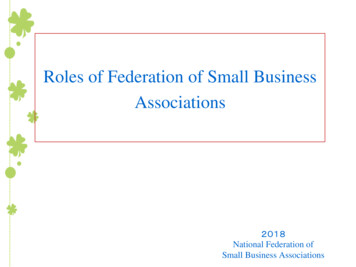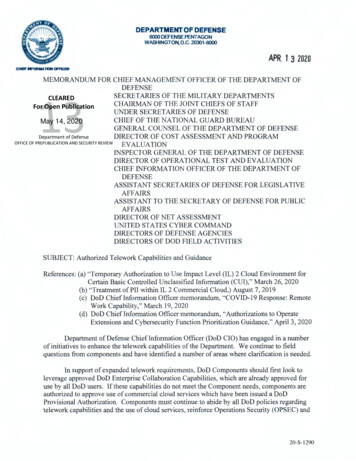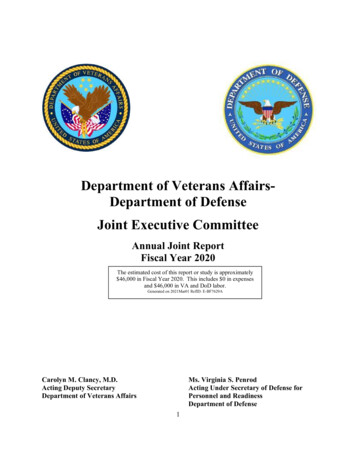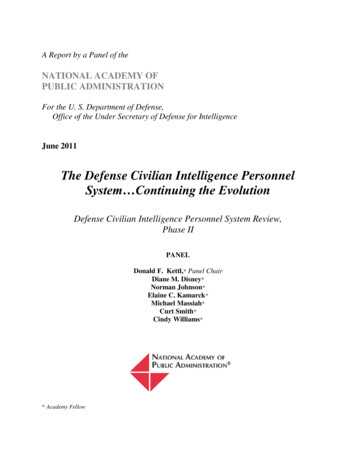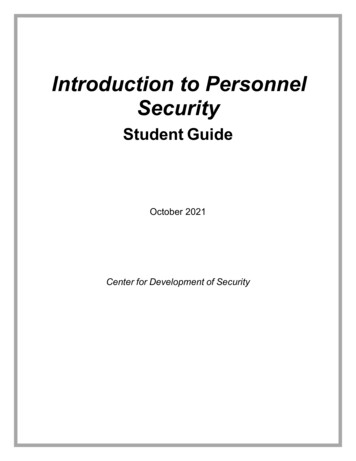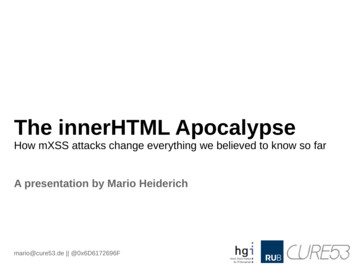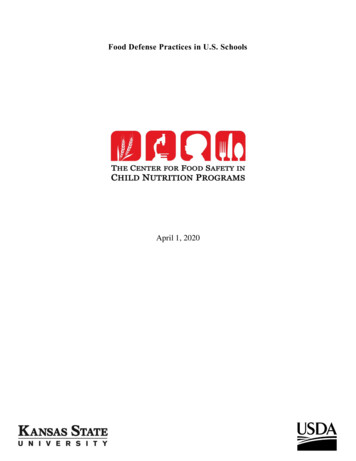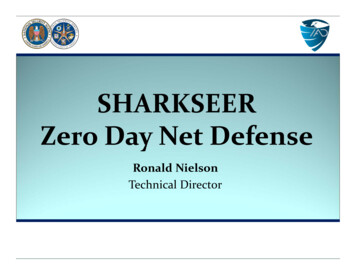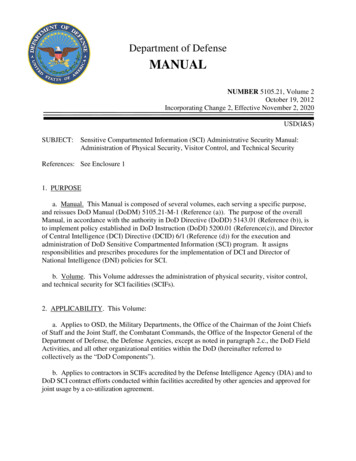
Transcription
Department of DefenseMANUALNUMBER 5105.21, Volume 2October 19, 2012Incorporating Change 2, Effective November 2, 2020USD(I&S)SUBJECT:Sensitive Compartmented Information (SCI) Administrative Security Manual:Administration of Physical Security, Visitor Control, and Technical SecurityReferences: See Enclosure 11. PURPOSEa. Manual. This Manual is composed of several volumes, each serving a specific purpose,and reissues DoD Manual (DoDM) 5105.21-M-1 (Reference (a)). The purpose of the overallManual, in accordance with the authority in DoD Directive (DoDD) 5143.01 (Reference (b)), isto implement policy established in DoD Instruction (DoDI) 5200.01 (Reference(c)), and Directorof Central Intelligence (DCI) Directive (DCID) 6/1 (Reference (d)) for the execution andadministration of DoD Sensitive Compartmented Information (SCI) program. It assignsresponsibilities and prescribes procedures for the implementation of DCI and Director ofNational Intelligence (DNI) policies for SCI.b. Volume. This Volume addresses the administration of physical security, visitor control,and technical security for SCI facilities (SCIFs).2. APPLICABILITY. This Volume:a. Applies to OSD, the Military Departments, the Office of the Chairman of the Joint Chiefsof Staff and the Joint Staff, the Combatant Commands, the Office of the Inspector General of theDepartment of Defense, the Defense Agencies, except as noted in paragraph 2.c., the DoD FieldActivities, and all other organizational entities within the DoD (hereinafter referred tocollectively as the “DoD Components”).b. Applies to contractors in SCIFs accredited by the Defense Intelligence Agency (DIA) and toDoD SCI contract efforts conducted within facilities accredited by other agencies and approved forjoint usage by a co-utilization agreement.
DoDM 5105.21-V2, October 19, 2012c. Does not apply to the National Security Agency/Central Security Service (NSA/CSS),National Geospatial-Intelligence Agency (NGA), and the National Reconnaissance Office (NRO),to which separate statutory and other Executive Branch authorities for control of SCI apply.3. DEFINITIONS. See Glossary.4. RESPONSIBILITIES. See Enclosure 2 of Volume 1 of this Manual.5. PROCEDURES. General procedures for SCI administrative security are found in Enclosure2, Volume 1 of this Manual. Procedures for physical security, visitor control, and technicalsecurity for SCI facilities are detailed in Enclosures 2, 3, and 4 respectively of this Volume.6. RELEASABILITY. Cleared for public release. This volume is available on the DirectivesDivision Website at https://www.esd.whs.mil/DD/.7. SUMMARY OF CHANGE 2. This administrative change:a. Updates the title of the Under Secretary of Defense for Intelligence to the Under Secretaryof Defense for Intelligence and Security in accordance with Public Law 116-92 (Reference (e)).b. Updates references.8. EFFECTIVE DATE. This Volume is effective October 19, 2012.Michael G. VickersUnder Secretary of Defense for IntelligenceEnclosures1. References2. Physical Security3. Visitor Control4. Technical SecurityGlossaryChange 2, 11/02/20202
DoDM 5105.21-V2, October 19, 2012TABLE OF CONTENTSENCLOSURE 1: REFERENCES .5ENCLOSURE 2: PHYSICAL SECURITY .7GENERAL .7SCIF DESIGN AND PLANNING .9SCIF TYPES .10CONSTRUCTION SECURITY .12SCIF ACCREDITATION.14SCIF OPERATIONS .18APPENDIXES1. SCIF CLOSEOUT GUIDELINES .302. SCIF END OF DAY SECURITY CHECK .313. EAPs FOR SCIFs WITHIN THE UNITED STATES .32ENCLOSURE 3: VISITOR CONTROL .34GENERAL .34BADGE RECIPROCITY IN THE METROPOLITAN WASHINGTON, D.C., AREA(MWA).34CERTIFICATION OF CLEARANCES AND SCI ACCESSES .34VISITS BY FOREIGN NATIONALS .37FOREIGN LIASION AND INTEGRATED PERSONNEL .38CERTIFICATION FOR PART-TIME EMPLOYMENT .38NON-INDOCTRINATED PERSONS .38CONTRACTORS AND CONSULTANTS .39ESCORTS .39ACCESS CONTROL.39ENCLOSURE 4: TECHNICAL SECURITY .41GENERAL .41TSCM SURVEYS AND EVALUATIONS .41CONTROL OF COMPROMISING EMANATIONS (TEMPEST).44CLASSIFYING TEMPEST RELATED INFORMATION.49GLOSSARY .50PART I. ABBREVIATIONS AND ACRONYMS .50PART II. DEFINITIONS .52Change 2, 11/02/20203CONTENTS
DoDM 5105.21-V2, October 19, 2012FIGURESample EAP Format .32Change 2, 11/02/20204CONTENTS
DoDM 5105.21-V2, October 19, 2012ENCLOSURE (n)(o)(p)(q)(r)(s)(t)(u)12DoD 5105.21-M-1, “Department of Defense Sensitive Compartmented InformationAdministrative Security Manual,” August 1998 (cancelled by Volume 1 of this Manual)DoD Directive 5143.01, “Under Secretary of Defense for Intelligence and Security(USD(I&S)),” October 24, 2014, as amendedDoD Instruction 5200.01, “DoD Information Security Program and Protection of SensitiveCompartmented Information (SCI),” April 21, 2016, as amendedDirector of Central Intelligence Directive 6/1, “Security Policy for SensitiveCompartmented Information and Security Policy Manual,” March 1, 1995 1Public Law 116-92, “National Defense Authorization Act for Fiscal Year 2020,”December 20, 2019Intelligence Community Directive 705, “Sensitive Compartmented Information Facilities,”May 26, 2010Intelligence Community Standard 705-1, “Physical and Technical Security Standards forSensitive Compartmented Information Facilities,” September 17, 2010Intelligence Community Standard 705-2, “Standards for the Accreditation and ReciprocalUse of Sensitive Compartmented Information,” September 17, 2010DoD Instruction 5200.08, “Security of DoD Installations and Resources and the DoDPhysical Security Review Board (PSRB),” December 10, 2005, as amendedDoD Directive 5205.02E, “DoD Operations Security (OPSEC) Program,” June 20, 2012, asamendedUnified Facilities Criteria 4-010-1, “DoD Minimum Antiterrorism Standards forBuildings,” 2002DoD Manual 5200.01, “DoD Information Security Program,” February 24, 2012, asamendedVolume 6 of U.S. Department of State Foreign Affairs Handbook 12, “OSPB SecurityStandards and Policy Handbook,” July 2006 2.Intelligence Community Directive 503, “Intelligence Community Information TechnologySystems Security Risk Management, Certification and Accreditation,” September 15, 2008DoD Directive 5205.07, “Special Access Program (SAP) Policy,” July 1, 2010, as amendedDoD Instruction 5205.11, “Management, Administration, and Oversight of DoD SpecialAccess Programs (SAPs),” February 6, 2013, as amendedDirector of Central Intelligence Directive 6/7, “Intelligence Disclosure Policy,”June 30, 1998DoD Directive 5230.20, “Visits and Assignments of Foreign Nationals,” June 22, 2005DoD Instruction 5530.03, “International Agreements,” December 4, 2019Intelligence Community Directive 701, “Security Policy Directive for UnauthorizedDisclosures of Classified Information,” March 14, 2007Army Regulation 380-27, “Control of Compromising Emanations,” May 19, 2010Available via y/policy/pages/dcids.aspx [JWICS]Available via http://source.ds.state.sgov.gov/products/library FAMsFAHs/FFhome.asp [SIPRNET]Change 2, 11/02/20205ENCLOSURE 1
DoDM 5105.21-V2, October 19, 2012(v) Air Force Instruction 71-101, Volume 3 “Air Force Technical SurveillanceCountermeasures Program,” June 1, 2000(w) Secretary of the Navy Instruction 3850.4, “Technical Surveillance Countermeasures,”December 8, 2000(x) Joint Staff Manual 5220.01A, “Temporary Restricted Area Access Request,”October 1, 1997(y) Administrative Instruction 30, “Force Protection of the Pentagon Reservation,”June 26, 2009, as amended(z) DoD Instruction 5240.05, “Technical Surveillance Countermeasures (TSCM) Program,”April 3, 2014, as amended(aa) Intelligence Community Directive 702, “Technical Surveillance Countermeasures,”February 18, 2008(ab) National Security Telecommunications Information System Security Advisory Manual2-95 & 2-95A, “RED/BLACK Installation Guidance” February 3, 2000(ac) National Security Telecommunications and Information Systems Security Instruction 7003,“Protected Distribution Systems (PDS),” December 3, 1996(ad) National Security Telecommunications and Information Systems Security Instruction7002,”TEMPEST Glossary,” March 17, 1995(ae) National Security Telecommunications and Information Systems Security Instruction 4002,“Classification Guide for COMSEC Information,” June 5, 1986Change 2, 11/02/20206ENCLOSURE 1
DoDM 5105.21-V2, October 19, 2012ENCLOSURE 2PHYSICAL SECURITY1. GENERALa. Physical security standards for the construction and protection of SCIFs are prescribed inIntelligence Community Directive (ICD) 705 (Reference (f)), Intelligence Community Standard(ICS) 705-1 (Reference (g)), and ICS 705-2 (Reference (h)). DoD SCIFs will be established inaccordance with those references and this Volume.(1) Wherever practical, SCIFs will be designated as a restricted area in accordance withDoD Instruction 5200.08 (Reference (i)). The special security officer (SSO) will coordinate tolist the SCIF within the post or installation directive that defines and designates all localrestricted areas and will post outside the SCIF the proper English and, when appropriate(overseas areas only), foreign language “Restricted Area” signs. If a SCIF is physically locatedwithin a restricted area, it does not also need to be designated as a controlled area.(2) Personnel who work in or have routine or unescorted access to a SCIF must beindoctrinated for the compartments of SCI that is discussed, processed, or stored within thefacility.(a) If a SCIF has multiple SCI control systems that are physically separated by aninternal access control device or other similar control system, only SCI-indoctrinated personnelwith the appropriate level of access for the facility will escort uncleared personnel. SCIF doorcombinations and bypass keys, if applicable, must be protected at the same level for which thefacility is accredited.(b) Main entry point combinations and bypass keys, if applicable, will be stored in adifferent SCIF of the same or higher accreditation.(c) Access codes to an intrusion detection system and access control device will belimited to personnel who are SCI-indoctrinated and have a need to know. Administratorprivileges to intrusion detection systems should be limited to the SSO.(3) Operations security (OPSEC) principles are critical for protecting the operationalactivities and security of SCIFs. OPSEC principles should be considered and implemented basedon the local security environment.(a) The facility’s location (complete address) and identity as a SCIF shall beprotected at a minimum of FOR OFFICIAL USE ONLY (FOUO). Drawings or diagramsidentified as a SCIF may not be posted on an UNCLASSIFIED website or transmitted over theInternet without some type of encryption.Change 2, 11/02/20207ENCLOSURE 2
DoDM 5105.21-V2, October 19, 2012(b) SCIFs should be referred to as a controlled space or another terminology so as notto designate it as a SCIF on releasable documents (e.g., bid requests, permit requests, subcontractor plans).(c) Refer to DoDD 5205.2 (Reference (j)) for further OPSEC guidance.(4) All new facilities shall be constructed as directed in References (g) and (h), and incompliance with Unified Facilities Criteria 4-010-1 (Reference (k)). SCIF construction overseasshall also comply with applicable local anti-terrorism and force protection regulations. SCIFsbuilt under Chief of Mission (COM) control will follow Department of State guidelines.b. Approvals. Reference (f) provides detailed physical security recommendations thatshould be applied. These recommendations are generally phrased with words such as “should,”“may,” and “can.” In some instances, such as speakerphones, answering machines, andsecondary doors, these recommendations are contingent upon accrediting official (AO) (DIACounterintelligence and Security Office (DAC)) approval. Requests must include adequatedetails that enable DAC to render an informed decision. DAC may delegate to seniorintelligence officials (SIOs) of the Combatant Commands the authority to approve TemporarySecure Working Areas (TSWAs), Temporary SCIFs (T-SCIFs), and concept statements forcreation of new SCIFs.c. Mitigations. Methods identified in the Intelligence Community (IC) TechnicalSpecifications contained in Reference (g) are an accepted way to meet the performance standard,but there may be several ways to achieve the same standard other than what is listed. A differentmethod may be used if it achieves the same performance standard as identified in Reference (f).This mitigation must be identified in the Fixed Facility Checklist (Attachment A to Reference(g)) and requires approval from the AO before implementation.d. Waivers(1) Reference (f) provides detailed physical security requirements. These requirementsare generally phrased with definitive words such as “will,” “shall,” and “must.” Requirements ofthis nature require a waiver whenever they cannot be followed and mitigations cannot be applied(i.e., a waiver down). A waiver is also required when these standards are exceeded (i.e., a waiverup).(2) All waiver requests will be submitted through the cognizant security authority (CSA),their designee, or the DoD Component SIO to DAC for review. If DAC determines that a waiveris warranted, it will process the waiver request for approval.(3) Waivers down will be guided by the principles of risk management. The requestmust be signed by the reviewing official (the CSA, their designee, or the DoD Component SIO)and at a minimum must include the following information:(a) The physical security requirement(s) that cannot be met.Change 2, 11/02/20208ENCLOSURE 2
DoDM 5105.21-V2, October 19, 2012(b) Explanation of why the security requirement cannot be implemented and themitigations that were considered.(c) Mission impact if the waiver is disapproved.(d) Identification of compensatory countermeasures that can be implemented in lieuof the established physical security requirements that can reduce the residual risk.(e) The time expectation on when the standard can be met and a waiver is no longerrequired.(4) Elements requesting waivers up must forward a written request through the CSA,their designee, or the DoD Component SIO to DAC. The request at a minimum must include thefollowing information:(a) The physical security requirement that will be exceeded.(b) A statement of documented risk that justifies the need to exceed standards.(c) Mission impact if the waiver is disapproved.(d) Identification of the additional security measures being put into place.(e) The time expectation on when the waiver will no longer be required.(5) Limitations on Waivers. Waivers are normally granted for a period of up to 1 year oruntil such time as the waiver is no longer needed. All waivers shall be reported to the Office ofthe Director of National Intelligence (ODNI) and maintained in the ODNI database. All SCIFswith permanent waivers will be reviewed annually using the current standards to determine if awaiver is still needed or if mitigations can be used instead. Elements requesting co-use of anySCIF with a waiver will be informed of it.(6) Classification Guidance. Guidance on classification of information related to theaccreditation of DoD SCIFs is maintained on the DAC JWICS /field/index.html). All SCIF documentationclassified under DIA classification authority shall be marked and transmitted per DoDM 5200.01(Reference (l)).2. SCIF DESIGN AND PLANNINGa. Site Planning(1) SCIF security begins with the decision to build a SCIF. Adequate planning anddesign will prevent many of the security risks to SCI and reduce the costs of construction. Siteplanning should include looking at the standoff distances for AT/FP as well as TEMPEST.Change 2, 11/02/20209ENCLOSURE 2
DoDM 5105.21-V2, October 19, 2012(2) The Service CSA or DoD Component SIO or their designees shall conduct one-timeconstruction project reviews before site acquisition (purchase or lease of a building) for thepurpose of making transparent, accountable, and prudent risk management decisions involvingsecurity requirements and long-term security risks.b. Concept Approval(1) The concept approval is the first critical element in the establishment of a SCIF.Concept approval certifies that a clear operational requirement exists for the SCIF and there is noexisting SCIF to support the requirement.(2) Once a need for SCI has been identified, the organization’s commander will submit arequest for SCI to the Service CSAs, their designees, or DoD Component SIOs. This requestwill identify the levels and types of SCI desired and certify that the organization is able tosupport the SCIF (i.e., manning and budget) throughout its lifecycle.(3) Upon receipt of the request to build a SCIF, the Service CSAs, their designees, orDoD Component SIOs will validate the need for a SCIF and the requirement for the requestedlevel of SCI. The Service CSAs, their designees, or DoD Component SIOs are required to grantconcept approval to establish a SCIF, to include contractor SCIFs. They may delegate thisapproval as deemed necessary. If delegated, the Service CSAs, their designees, or DoDComponent SIOs must notify DAC to preclude potential confusion.(4) The Service CSAs, their designees, or DoD Component SIOs will provide theconcept approval and, if applicable, the DD Form 254, “Contract Security ClassificationSpecification,” for contractor facilities to DAC with an information copy to the supporting SSO.c. Diplomatic Facilities(1) DoD SCIFs established within diplomatic facilities fall under the securityresponsibility of the COM and must also obtain permission through Department of Statechannels to build a SCIF. These SCIFs will comply with all requirements of Reference (f) andmeet the Overseas Security Policy Board (OSPB) standards in accordance with Volume 6 of U.S.Department of State Foreign Affairs Handbook 12 (Reference (m)).(2) Where OSPB standards and DoD standards conflict, the more stringent will beapplied unless resolved by DAC and the Department of State Bureau of Diplomatic Security.3. SCIF TYPESa. Temporary SCIFs(1) TSWAChange 2, 11/02/202010ENCLOSURE 2
DoDM 5105.21-V2, October 19, 2012(a) A TSWA must not be used more than 40 hours per month and no longer than 12months in the same location. The 40-hour rule is based on an average use of the TSWA over a12-month period. The purpose for this requirement is that a TSWA’s physical security standardsare less than that of a permanently accredited SCIF. If the facility will be used on a morefrequent basis, the user of a facility must pursue permanent accreditation. On a case-by-casebasis and with sufficient justification, DAC may approve SCI storage (not to exceed 6 months).(b) The Service CSAs, their designees, or DoD Component SIOs may approveTSWAs for all compartments of SCI. Approval for processing SCI in TSWAs may only begranted by DIA or heads of the intelligence and counterintelligence elements of the MilitaryServices, Combatant Commands, and Defense Agencies according to their respectiveinformation system (IS) accreditation authority.(c) Active TSWA status will be annotated on the DIA JWICs share point site by theapplicable Service CSAs, their designees, or DoD Component SIOs.(2) T-SCIF(a) T-SCIFs are used in support of tactical, contingency, and field-training operationsfor a limited time where physical security construction standards associated with permanentfacilities are not possible. They may include hardened structures (buildings, bunkers, etc.),truck-mounted or towed military shelters, tents, prefabricated modular trailers or buildings, andareas used on aircraft and surface and subsurface vessels.(b) The Service CSAs, their designees, or DoD Component SIOs may establish andgrant temporary accreditation to operate a T-SCIF. These officials may further delegate thisapproval, in writing, to a lower level of command providing continued oversight is maintained.No further delegation is authorized. T-SCIF approvals will be valid for up to 1 year.Consideration must be given to establishing a permanent SCIF whenever it is known that the TSCIF will be required for a period greater than 1 year. Extension beyond the 1-year period mustbe justified in writing to DAC, which retains approval authority.(c) Active T-SCIF status will be annotated on the DIA JWICs sharepoint site by theapplicable Service CSAs, their designees, or DoD Component SIOs.(d) Elements establishing or operating a T-SCIF within a deployed theater will notifythe respective Combatant Command SSO within 48 hours. Such elements will also provideupdates relating to the current location and status of T-SCIF under their control as directed by theCombatant Command SSO.(e) Refer to Chapter 5, “IC Technical Specifications,” of Reference (f) for detailedphysical security requirements for T-SCIFs. DAC is the approving authority whenever theapplication of a specific physical security requirement cannot be achieved in response to anunprecedented or unique operating environment.Change 2, 11/02/202011ENCLOSURE 2
DoDM 5105.21-V2, October 19, 2012(f) The information assurance manager (IAM) must obtain Automated InformationSystem (AIS) accreditations in accordance with Reference (f). The designated approvalauthority (DAA) shall decide whether to grant accreditation approval to operate a system basedon all available documentation and mitigating factors. The DAA may grant approval to operate asystem as certified or grant interim approval to operate identifying the steps and any additionalcontrols to be completed prior to full accreditation.(g) The T-SCIF accrediting authority is responsible for ensuring that the TEMPESTrequirements for the T-SCIF are followed. These requirements are outlined in Enclosure 4 ofthis Volume of this Manual. If these requirements cannot be met, DIA’s Certified TEMPESTTechnical Authority (CTTA) must be consulted.b. Permanent SCIF. DAC is the sole accrediting authority for physical and technical(TEMPEST) security for permanent SCI facilities.(1) Secure Working Areas (SWAs). SWAs are accredited and used for handling,discussing, and processing but SCI is not stored in them. Since there is no time limit on theiraccreditation, SWAs require a higher level of security than TSWAs and T-SCIFs. The SWAshall be controlled at all times by SCI indoctrinated individuals or secured with a GeneralServices Administration (GSA)-approved pedestrian deadbolt meeting Federal specification FFL-2890. All SCI used in a SWA shall be moved to an accredited SCIF at the end of eachbusiness day or destroyed using CSA approved methods. There shall be a plan to relocate ordestroy SCI material in the event of an emergency or natural disaster. This plan shall be testedsemi-annually.(2) Continuous Operations SCIFs. This SCIF is staffed and operated 24 hours a day, 7days a week. Staffed refers to personnel who possess the appropriate security clearance and arepermanently assigned to the SCIF as opposed to the guard force. There should be enoughpersonnel continuously present to observe all areas that provide access to the SCIF to includeprimary, secondary, and emergency exit doors.(3) Open Storage SCIFs. Open storage SCIFs allow SCI to be openly stored within theSCIF without using GSA-approved storage containers. Open storage construction requirementsshall be met.(4) Closed Storage SCIFs. All SCI material must be stored in a GSA-approved securitycontainer in an accredited facility.4. CONSTRUCTION SECURITYa. The renovation of existing SCIFs and the construction of new SCIFs shall meet thesecurity requirements outlined in Reference (f). Any variances of these requirements must beapproved by DAC prior to their implementation.Change 2, 11/02/202012ENCLOSURE 2
DoDM 5105.21-V2, October 19, 2012b. An SCI-indoctrinated site security manager (SSM) shall be designated by the componentSSO for each new construction or renovation project. The SSM may be a U.S. Government(USG) employee, military member, or contractor, but will not be employed by the constructionfirm completing the project. The SSM represents the organization constructing or renovating theSCIF for all security matters to both the construction firm and the AO.(1) The SSM shall develop a construction security plan (CSP) for each project. The planshall include a risk assessment of the threats against the project to include human intelligence(HUMINT), counterintelligence (CI), technical, and AT/FP. The threat sources identified inReference (f) must be used, but additional threat assessments from local sources should beutilized to define the total threat.(2) The complexity and scope of the CSP will depend on the project. Simplemodifications may only be a few pages, while the construction of a new building may be severalhundred pages. Project work schedule and related documents shall be provided to the SSM inorder to adequately consider and implement prudent or required security measures.(3) The SSM, during the course of the project, shall establish appropriate security files.These files may include work schedules, picture ID cards and access records, local guardincident and other reports, inspection reports, copies of security violations, and similarsubstantive project documentation as deemed appropriate by the SSM.(4) SSMs shall have 24-hour unrestricted access to on-site construction offices and areasto conduct security inspections. This does not mean that the SSM has to be on site at all times.During construction or renovations, the SSM shall conduct unannounced security surveys atrandom intervals to meet appropriate security procedures.(5) The SSM shall be responsible for access control of the site and verify that theconstruction site is clear of all uncleared workers during non-duty hours.c. During the design phase and prior to the start of construction, a CSP shall be developed bythe SSM. A CSP template is available on the DIA SCIF JWICS accreditation eld/index.html).(1) Security officials overseeing SCIF construction projects shall submit the CSP toDAC at the 30 percent design point along with the completed risk assessment. Based on thesetwo documents, DAC will issue CSP guidance. The SSM will continue to update the CSP asappropriate and develop SOPs for use on the project. Component SSOs will monitor thedevelopment and implementation of the CSP. TEMPEST requirements will also be identifiedduring this time in accordance with Enclosure 4 of this Volume.(2) A facility under the COM, the CSP must be confirmed or certified in accordance withthe OSPB in accordance with Reference (m). Assistance in developing a CSP can be obtainedthrough DAC or the local Department of State representative.Change 2, 11/02/202013ENCLOSURE 2
DoDM 5105.21-V2, October 19, 2012d. SCI-indoctrinated escorts are required when uncleared workers have access to SCIF areas.The ratio of escorts will be determined on a case-by-case basis by the SSM. Prior to assumingescort duties, escorts shall receive a briefing outlining their individual responsibilities.e. Security checks will be performed on construction personnel to the greatest extentpractical. Security checks shall, at a minimum, consist of local records checks conducted bymilitary installation visitor and pas
DoDM 5105.21-V2, October 19, 2012. Change 2, 11/02/2020 6 ENCLOSURE 1 (v) Air Force Instruction 71-101, Volume 3 "Air Force Technical Surveillance
